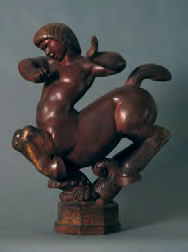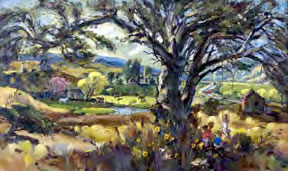FIRST GENERATION: Art in Claremont, 1907–1957 Opens Sunday, January 27
(December 12, 2007)— The Claremont Museum of Art is pleased to present First Generation: Art in Claremont, 1907–1957, which traces the art history of Claremont and the region in the first 50 years after the city’s incorporation in 1907. First Generation opens with a public reception from 3 to 5 p.m. on Sunday, January 27, 2008 and runs through Sunday, April 27.

Plaster
Scripps College Collection
On a clear day a century ago, one could see the peak of Mt. Baldy from virtually every corner of the Los Angeles basin, from ocean to desert. The original inhabitants of this area, the Tongva/Gabrielino Indians, called the mountain “Yoát,” or snow. Its siren song has drawn generations of settlers to its shadow. Since the late 19th century, prominent artists have been among those attracted to the foothills of Mt. Baldy and its neighboring peaks—and the city of Claremont, in particular. Whether it was the allure of the “great bald mountain” and its surrounding chaparral that first attracted painters and photographers to Claremont, or the opportunities provided by the birth of the schools and colleges founded to serve a rapidly growing population, a large number of distinguished visual artists settled here, greatly enriching the culture of the region and establishing early-on its prominence as an artistic haven.

Oil on canvas
Scripps College Collection
First Generation traces the art history of the region, from the work of such artists as Hannah Tempest Jenkins, Emil Kosa, Jr., and William Manker to that of Millard Sheets and his circle in the 1930s. Sheets’s influence as artist and teacher extended as well to bringing artists such as Henry Lee McFee, Phil Dike, and Jean Ames to Scripps College, thereby enhancing the existing art community and assuring its lasting influence.
“This exhibition includes the work of these and other artists important to Claremont’s history and reflects the conviction on which the Claremont Museum of Art is based,” says Curator Steve

Oil on linen
Private Collection, Courtesy Claremont Fine Arts
Comba. “That Claremont’s artistic heritage is a rich and valuable resource for both present and future generations, one that deserves to be examined and celebrated.”
On View Through December 30: Ephemeral: Explorations in Light, a multi-media show on light featuring dynamic installations and sculptures by Iñaki Bonillas (Mexico City), Elaine Buckholtz (San Francisco), Thomas Glassford (Mexico City), Won Ju Lim (Los Angeles), and C.E.B. Reas (Los Angeles).
On view through January 1: San Francisco-based photographer Christopher Irion set up shop outside the Claremont Library and photographed community members who ventured inside his portable photo booth. The resulting 214 images are on view on a 72-foot-wide and eight-foot-tall mural at the Lemon Packing House east plaza. FREE TO THE PUBLIC.
About the Museum: The Claremont Museum of Art seeks to serve a diverse public as a regional museum of international significance and breadth. Grounded in Claremont’s important artistic legacy, the Museum engages artists and audiences through a compelling program of exhibitions and educational programs that connect the visual arts with contemporary life. In addition to a diverse slate of exhibitions, the museum features an eclectic store offering contemporary and unexpected gifts from around the world. A comprehensive slate of educational programming and events are offered for all ages. Claremont Museum of Art is an independent, nonprofit
501(c)(3) organization.
